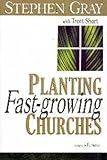Church plants that grow. . . FAST

If you're into church planting and you want them to grow, or at least survive here's a promising book based on research of plants that grew fast and those that didn't: “Planting Fast-Growing Churches†(Stephen Gray)
Living in the southern hemisphere means that I don't have a copy yet but will rely on Dave DeVries for a list of interesting findings.
- Church planters who had strong emotional support, personal investment, and conceptual freedom were more likely to succeed than those who had weaker support, investment, or freedom.
- Church plants who received more funding for longer periods of time were overall less effective than churches that received less funding for shorter periods of time.
- If a church plant doesn't break 200 in weekly attendance within its first two years, there is an increased likelihood that it never will.
- 93% of church plants do not reach 200 in attendance and become self-supporting within three years.
- If a planter cannot bring a church plant to be self-supporting within three years, this likely means that the wrong leader has been chosen.
- A shorter period of financial support forces the planter to be more aggressive in growing the church, raising additional funds, and teaching stewardship. An extended period of support is detrimental to the development of a church plant.
- Church planters who received specialized training achieved a worship attendance that was three times higher than those who received no training.
- 88% of fast-growing church plants had a church planting team in place prior to public launch. By contrast, only 12 percent of struggling church plants had a church planting team.
- An approach that utilizes a healthy dose of both small groups and preview services is the best way to go about building a large core group.
- 92% of growing church plants offered three or more ministry opportunities from Day 1 (typically worship, children, and youth). Conversely, 64% of struggling church plants offered only an adult worship service on Day 1.
- The early introduction of stewardship teaching is a critical factor affecting the size and survivability of a new church. According to this research, after four years, church plants that expected tithing experienced an average attendance of 120. Those new churches that did not teach any form of financial stewardship averaged around ninety in attendance.
Next post, the 21 major differences between church plants that grew fast and those that didn't.

